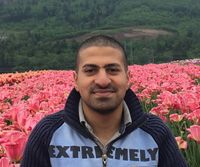CAZypedia needs your help! We have many unassigned GH, PL, CE, AA, GT, and CBM pages in need of Authors and Responsible Curators.
Scientists at all career stages, including students, are welcome to contribute to CAZypedia. Read more here, and in the 10th anniversary article in Glycobiology.
New to the CAZy classification? Read this first.
*
Consider attending the 15th Carbohydrate Bioengineering Meeting in Ghent, 5-8 May 2024.
Difference between revisions of "User:Mohamed Attia"
Harry Brumer (talk | contribs) m (Text replacement - "\^\^\^(.*)\^\^\^" to "$1") |
|||
| Line 1: | Line 1: | ||
[[Image:MATTIA.jpg|200px|right]] | [[Image:MATTIA.jpg|200px|right]] | ||
| − | Mohamed Attia obtained his B.Sc. in Pharmacy from Alexandria University, Egypt. He then completed his M.Sc. in the Department of Biological Sciences at University of Calgary where he studied the biosynthetic pathway of the sweet sesquiterpene hernandulcin from ''Lippia dulcis'' leaves <cite>Attia2012</cite>. He then pursued his Ph.D. in the Department of Chemistry at University of British Columbia under the supervision of | + | Mohamed Attia obtained his B.Sc. in Pharmacy from Alexandria University, Egypt. He then completed his M.Sc. in the Department of Biological Sciences at University of Calgary where he studied the biosynthetic pathway of the sweet sesquiterpene hernandulcin from ''Lippia dulcis'' leaves <cite>Attia2012</cite>. He then pursued his Ph.D. in the Department of Chemistry at University of British Columbia under the supervision of [[User:Harry Brumer|Harry Brumer]]. During his Ph.D., Mohamed extensively studied the xyloglucan degradation pathway in the soil saprophyte ''Cellvibrio japonicus'' and he successfully identified and functionally characterized a large suite of glycoside hydrolases from families [[GH3]] <cite>Nelson2017</cite>, [[GH5]] <cite>Attia2018</cite> and [[GH74]] <cite>Attia2016</cite> that are fundamentally involved in the saccharification process. |
Latest revision as of 14:34, 18 December 2021
Mohamed Attia obtained his B.Sc. in Pharmacy from Alexandria University, Egypt. He then completed his M.Sc. in the Department of Biological Sciences at University of Calgary where he studied the biosynthetic pathway of the sweet sesquiterpene hernandulcin from Lippia dulcis leaves [1]. He then pursued his Ph.D. in the Department of Chemistry at University of British Columbia under the supervision of Harry Brumer. During his Ph.D., Mohamed extensively studied the xyloglucan degradation pathway in the soil saprophyte Cellvibrio japonicus and he successfully identified and functionally characterized a large suite of glycoside hydrolases from families GH3 [2], GH5 [3] and GH74 [4] that are fundamentally involved in the saccharification process.
Error fetching PMID 29052930:
Error fetching PMID 29467823:
Error fetching PMID 26929175:
- Error fetching PMID 22867794:
- Error fetching PMID 29052930:
- Error fetching PMID 29467823:
- Error fetching PMID 26929175:
